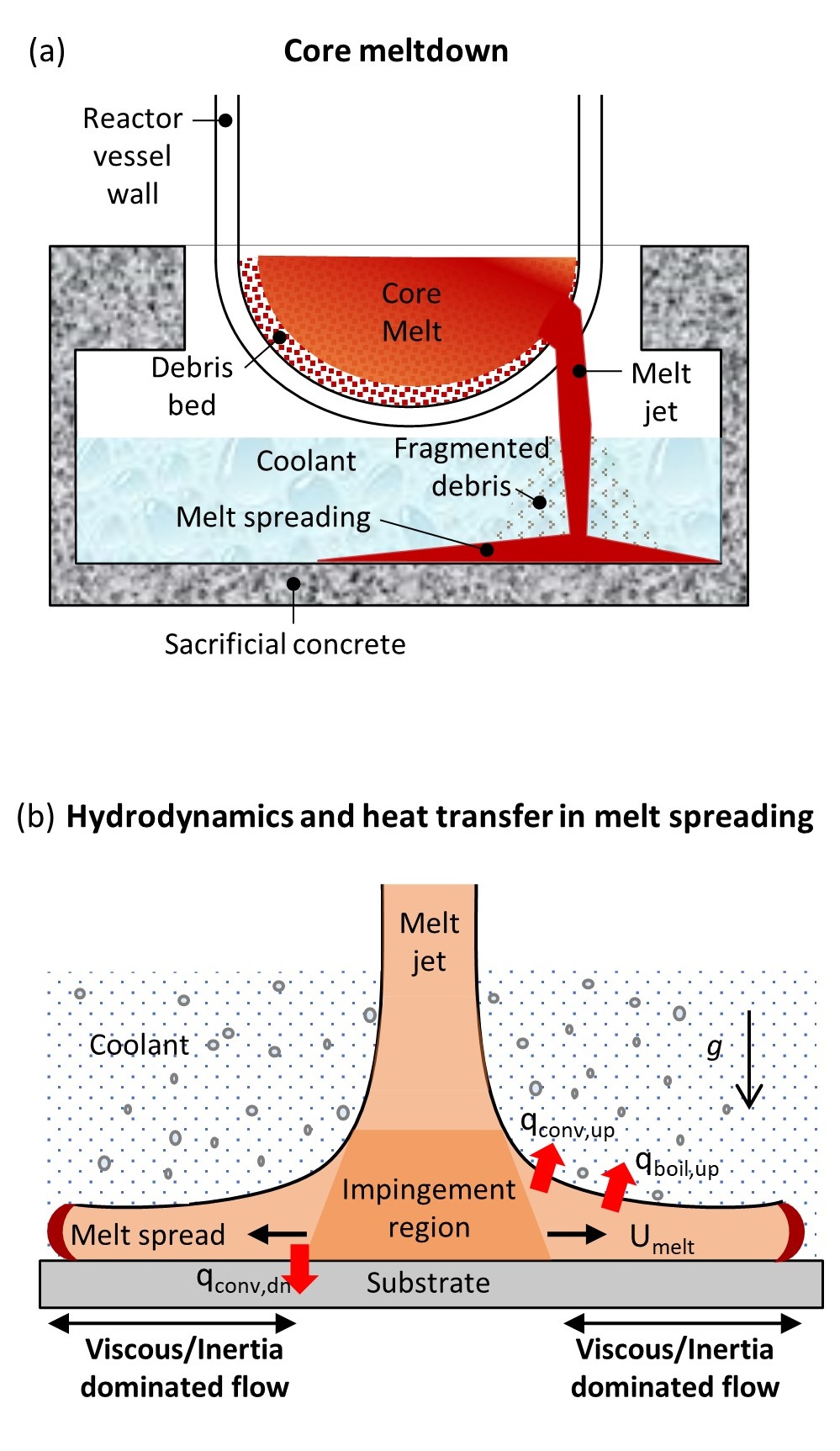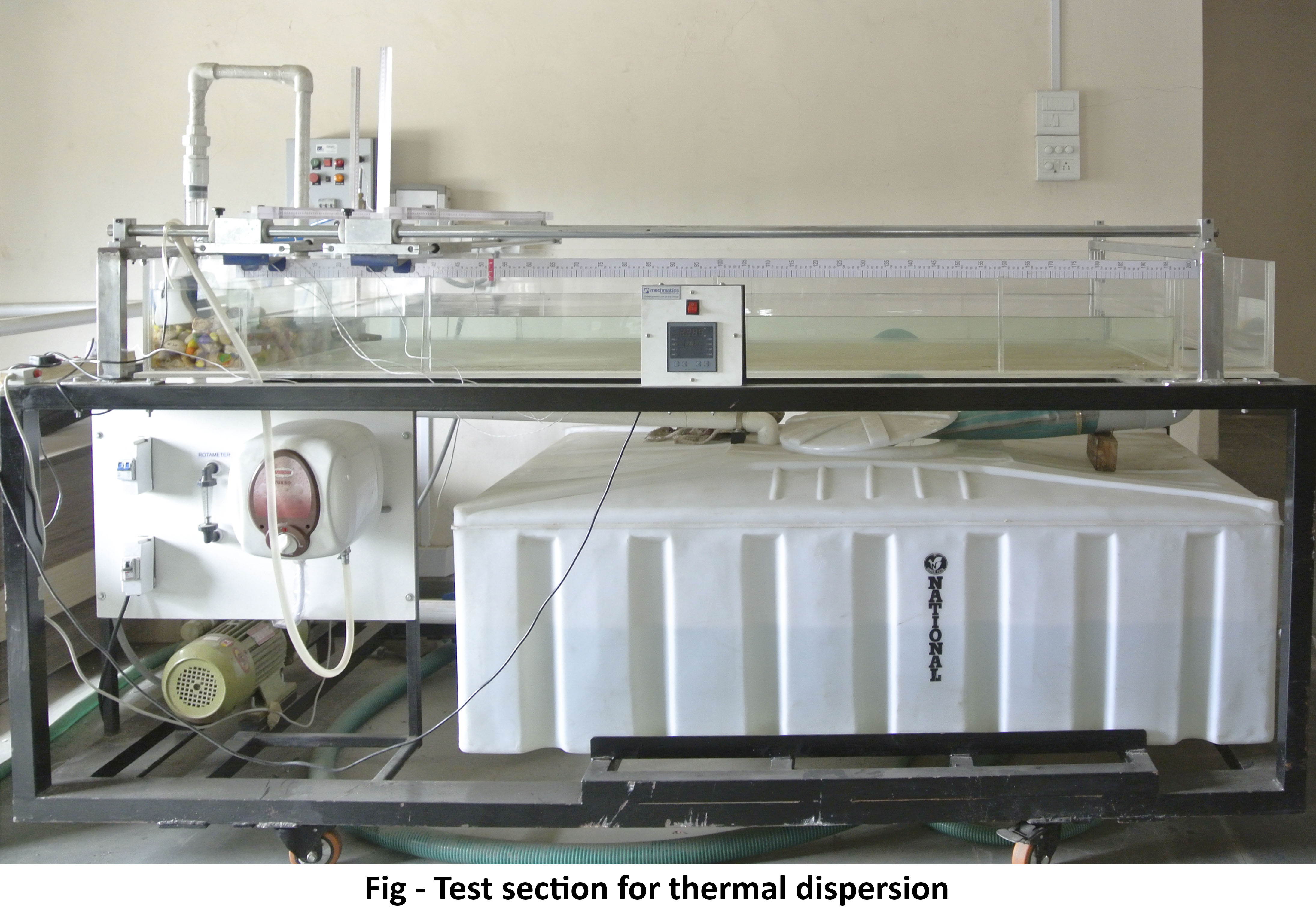Research
Research Interests
Current Research
A. Corium Simulant Melt Underwater Spreading:
The spread of corium on the containment cavity with a shallow water pool is depicted in Figure (a). The ex-vessel corium interaction includes the jet region, impingement region, and spreading region as shown in Figure (b). The melt is barely cooled during the first two regions. The main cooling occurs during or after the melt spreading. The spreading is governed by three main forces, namely the gravity force, inertia force, and viscous force. These forces dictate the spreading to be either inertia-gravity dominated or viscous-gravity dominated. The gravity force spreads the melt over the substrate surface until either molecular forces or solidification stops its movement.
A new facility, Co-rium Simulant Melt Underwater Spreading (CoSMUS) facility, is developed to study the hydrodynamic and thermal interaction of corium during its horizontal spreading over the substrate in a shallow water pool. The cylindrical gate system in the middle of the test section skips the melt jet and impingement regions. A special quartz substrate is used for melt spreading, providing several advantages such as low thermal conductivity, low thermal stress, and advanced measurement capabilities. The facility aims to fill the gaps in the sparse ex-vessel interaction data of corium by providing a high-quality database to understand the phenomenology and develop numerical codes.
B. Radiation modelling of in-vessel melt cooloability:
C. Spray cooling for In-Vessel Melt Retention (IVMR):
Ph.D. Thesis
- Synopsis (Click here to download)
- Full thesis (Download link)
Supervisor: Prof. Sameer Khandekar
Title: Containment Thermal Hydraulic Studies towards Understanding Post-Severe Nuclear Accident Scenario

To study the thermal hydraulics of an NPP containment, we built a Thermal HYdraulic test facility for CONtainment (THYCON). This facility is designed to simulate various phenomena such as stratification, mixing, natural circulation, wall and bulk condensation, which occur in the containment building and govern the progression of a severe accident. The test vessel of the facility (diameter 0.97 m and length 3.6 m), with various accessories and instrumentation, was used for the experiments.
The experiments involved different injection heights, volumetric Richardson numbers, and compositions of gases at certain condenser wall temperature and vessel conditions. Data was collected through a heat flux measurement system, an online mass spectrometer, DAQ-based pressure sensors, and thermocouples. Our findings showed that stratification is time-dependent and can exist for long periods. Also, significant stratification was observed at lower volumetric Richardson numbers (~0.1). The natural circulation was caused by the buoyancy-driven upward and downward movement near the cold condensing walls. With a decrease in inlet flow, the circulation zone decreases and becomes more confined in the vicinity of the injection location. The condenser located near the circulation zone showed higher magnitudes of condensation heat flux in experiments at higher pressure.
Our experimental database and analysis are valuable for safety analysis, code validation, and correlation development, in collaboration with BARC and BRNS. This work benefits research centers and academia in terms of safety assessment and design of containments, as well as new experiments in the field of nuclear containment safety.
M.Tech. Thesis
Supervisor: Prof. Jyotirmay BanerjeeTitle: Analysis of Dispersion of Heated Effluent in Lake Scenario

Power plants make use of vast amounts of water as a secondary coolant. This water, after carrying excess heat, is usually disposed of back into the lake or water body from which it was sourced. Although the lake is considered an infinite heat sink, its temperatures rise significantly, leading to severe disruptions to the surrounding flora and fauna. Hence, the impact of heated effluent dispersion in lakes was studied in-depth.
To understand the thermal dispersion in the lake, various parameters such as convection, turbulence, and surface interactions were calculated experimentally using a scaled-down model. In laboratory experiments, the coastal area was scaled down using the important non-dimensional numbers, densimetric Froude number, and Reynolds number. The velocity field and turbulence of the flow were measured using Acoustic Doppler Velocimeter (ADV), while the temperature field and heat transfer were obtained from the thermocouples.
The study concluded that the problem of waste heat dispersion must be studied in two parts- near-field dispersion and far-field dispersion. The near-field heat dispersion is a complex 3D problem that depends on the inlet conditions and immediate surroundings. This zone is most susceptible to thermal shocks, which can be reduced by efficient dispersion systems such as multiport outlets and artificial vortex generators. The far-field heat dispersion is a 2D problem, with the heat dispersion primarily occurring in the top layer. The temperature distribution depends on near-field temperatures and water surface interactions with the environment such as wind velocity, surrounding temperatures, and humidity.
In conclusion, the study provided important scaling parameters, highlighted the zones of importance in lakes, the impact of effluent in the near-field and far-field, the effect of turbulence, and possible methods to eliminate thermal shocks. This study was later extended to Moticher Lake, Kakrapar Atomic Power Station, India, to solve the real-world problem faced by power plant authorities.

